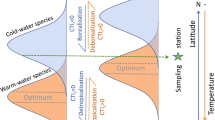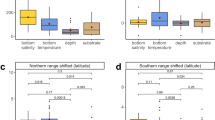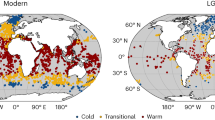Abstract
As ocean temperatures rise, species distributions are tracking towards historically cooler regions in line with their thermal affinity1,2. However, different responses of species to warming and changed species interactions make predicting biodiversity redistribution and relative abundance a challenge3,4. Here, we use three decades of fish and plankton survey data to assess how warming changes the relative dominance of warm-affinity and cold-affinity species5,6. Regions with stable temperatures (for example, the Northeast Pacific and Gulf of Mexico) show little change in dominance structure, while areas with warming (for example, the North Atlantic) see strong shifts towards warm-water species dominance. Importantly, communities whose species pools had diverse thermal affinities and a narrower range of thermal tolerance showed greater sensitivity, as anticipated from simulations. The composition of fish communities changed less than expected in regions with strong temperature depth gradients. There, species track temperatures by moving deeper2,7, rather than horizontally, analogous to elevation shifts in land plants8. Temperature thus emerges as a fundamental driver for change in marine systems, with predictable restructuring of communities in the most rapidly warming areas using metrics based on species thermal affinities. The ready and predictable dominance shifts suggest a strong prognosis of resilience to climate change for these communities.
This is a preview of subscription content, access via your institution
Access options
Access Nature and 54 other Nature Portfolio journals
Get Nature+, our best-value online-access subscription
$29.99 / 30 days
cancel any time
Subscribe to this journal
Receive 12 print issues and online access
$209.00 per year
only $17.42 per issue
Buy this article
- Purchase on Springer Link
- Instant access to full article PDF
Prices may be subject to local taxes which are calculated during checkout



Similar content being viewed by others
Data availability
The data that support the findings of this study are available from the publicly accessible repositories listed in Supplementary Table 1. The CTI values and species thermal affinity data that support the findings of this study are available as annual values and 30-year means36 (Supplementary Fig. 7) and as trends37 in 2° × 2° grid cells (Figs. 2 and 3 and Supplementary Fig. 5). Species thermal affinities derived from models and observations are also available38. Source data for the analyses presented are available at the links given in the Supplementary Information files39,40,41,42,43,44,45,46.
Code availability
Source code for the simulation of CTI response to temperature change in Fig. 1 is available at https://github.com/michaeltburrows/ctisimulation.
References
Poloczanska, E. S. et al. Global imprint of climate change on marine life. Nat. Clim. Change 3, 919–925 (2013).
Pinsky, M. L., Worm, B., Fogarty, M. J., Sarmiento, J. L. & Levin, S. A. Marine taxa track local climate velocities. Science 341, 1239–1242 (2013).
Jones, M. C. & Cheung, W. W. L. Multi-model ensemble projections of climate change effects on global marine biodiversity. ICES J. Mar. Sci. 72, 741–752 (2015).
García Molinos, J. et al. Climate velocity and the future global redistribution of marine biodiversity. Nat. Clim. Change 6, 83–88 (2016).
Devictor, V. et al. Differences in the climatic debts of birds and butterflies at a continental scale. Nat. Clim. Change 2, 121–124 (2012).
Cheung, W. W. L., Watson, R. & Pauly, D. Signature of ocean warming in global fisheries catch. Nature 497, 365–368 (2013).
Perry, A. L., Low, P. J., Ellis, J. R. & Reynolds, J. D. Climate change and distribution shifts in marine fishes. Science 308, 1912–1915 (2005).
Lenoir, J., Gégout, J. C., Marquet, P. A., de Ruffray, P. & Brisse, H. A significant upward shift in plant species optimum elevation during the 20th century. Science 320, 1768–1771 (2008).
Lindström, Å., Green, M., Paulson, G., Smith, H. G. & Devictor, V. Rapid changes in bird community composition at multiple temporal and spatial scales in response to recent climate change. Ecography 36, 313–322 (2013).
Nieto-Sánchez, S., Gutiérrez, D. & Wilson, R. J. Long-term change and spatial variation in butterfly communities over an elevational gradient: driven by climate, buffered by habitat. Divers Distrib. 21, 950–961 (2015).
Santangeli, A., Rajasärkkä, A. & Lehikoinen, A. Effects of high latitude protected areas on bird communities under rapid climate change. Glob. Change Biol. 23, 2241–2249 (2017).
Bertrand, R. et al. Changes in plant community composition lag behind climate warming in lowland forests. Nature 479, 517–520 (2011).
De Frenne, P. et al. Microclimate moderates plant responses to macroclimate warming. Proc. Natl Acad. Sci. USA 110, 18561–18565 (2013).
Flanagan, P. H., Jensen, O. P., Morley, J. W. & Pinsky, M. L. Response of marine communities to local temperature changes. Ecography 42, 214–224 (2019).
Sunday, J. M., Bates, A. E. & Dulvy, N. K. Thermal tolerance and the global redistribution of animals. Nat. Clim. Change 2, 686–690 (2012).
Deutsch, C. A. et al. Impacts of climate warming on terrestrial ectotherms across latitude. Proc. Natl Acad. Sci. USA 105, 6668–6672 (2008).
Stuart-Smith, R. D., Edgar, G. J., Barrett, N. S., Kininmonth, S. J. & Bates, A. E. Thermal biases and vulnerability to warming in the world’s marine fauna. Nature 528, 88–92 (2015).
Burrows, M. T. et al. The pace of shifting climate in marine and terrestrial ecosystems. Science 334, 652–655 (2011).
Beaugrand, G. Theoretical basis for predicting climate-induced abrupt shifts in the oceans. Phil. Trans. R. Soc. B 370, 20130264 (2015).
Brown, J. H. On the relationship between abundance and distribution of species. Am. Nat. 124, 255–279 (1984).
Waldock, C., Stuart-Smith, R. D., Edgar, G. J., Bird, T. J. & Bates, A. E. The shape of abundance distributions across temperature gradients in reef fishes. Ecol. Lett. 22, 685–696 (2019).
Sagarin, R. D. & Gaines, S. D. The ‘abundant centre’ distribution: to what extent is it a biogeographical rule? Ecol. Lett. 5, 137–147 (2002).
Rayner, N. A. et al. Global analyses of sea surface temperature, sea ice, and night marine air temperature since the late nineteenth century. J. Geophys. Res. 108, 4407 (2003).
Good, S. A., Martin, M. J. & Rayner, N. A. EN4: quality controlled ocean temperature and salinity profiles and monthly objective analyses with uncertainty estimates. J. Geophys. Res. Oceans 118, 6704–6716 (2013).
Beaugrand, G., Luczak, C. & Edwards, M. Rapid biogeographical plankton shifts in the North Atlantic Ocean. Glob. Change Biol. 15, 1790–1803 (2009).
Dulvy, N. K. et al. Climate change and deepening of the North Sea fish assemblage: a biotic indicator of warming seas. J. Appl. Ecol. 45, 1029–1039 (2008).
Pinsky, M. L., Eikeset, A. M., McCauley, D. J., Payne, J. L. & Sunday, J. M. Greater vulnerability to warming of marine versus terrestrial ectotherms. Nature 569, 108–111 (2019).
Wernberg, T. et al. An extreme climatic event alters marine ecosystem structure in a global biodiversity hotspot. Nat. Clim. Change 3, 78–82 (2013).
Doak, D. F. & Morris, W. F. Demographic compensation and tipping points in climate-induced range shifts. Nature 467, 959–962 (2010).
Chaudhary, C., Saeedi, H. & Costello, M. J. Bimodality of latitudinal gradients in marine species richness. Trends Ecol. Evol. 31, 670–676 (2016).
Burrows, M. T. et al. Geographical limits to species-range shifts are suggested by climate velocity. Nature 507, 492–495 (2014).
Pörtner, H. O. & Farrell, A. P. Physiology and climate change. Science 322, 690–692 (2008).
Kramer-Schadt, S. et al. The importance of correcting for sampling bias in MaxEnt species distribution models. Divers. Distrib. 19, 1366–1379 (2013).
Rodríguez-Sánchez, F., De Frenne, P. & Hampe, A. Uncertainty in thermal tolerances and climatic debt. Nat. Clim. Change 2, 636–637 (2012).
Dell, A. I., Pawar, S. & Savage, V. M. Systematic variation in the temperature dependence of physiological and ecological traits. Proc. Natl Acad. Sci. USA 108, 10591–10596 (2011).
Burrows, M. T. Community Temperature Index values for North Pacific and North Atlantic bottom trawls and plankton in 2° latitude/longitude areas annually from 1985 to 2014. Figshare https://doi.org/10.6084/m9.figshare.9699068 (2019).
Burrows M. T. Trends in Community Temperature Index values for North Pacific and North Atlantic bottom trawl and plankton surveys for 2° latitude/longitude boxes from 1985 to 2014. Figshare https://doi.org/10.6084/m9.figshare.9699107 (2019).
Burrows M. T., Payne B. L. Species Temperature Index and thermal range information for North Pacific and North Atlantic plankton and bottom trawl species. Figshare https://doi.org/10.6084/m9.figshare.6855203.v1 (2018).
Brodie, B., Mowbray, F. & Power, D. DFO Newfoundland and Labrador Region Ecosystem Trawl Surveys (Bedford Institute of Oceanography, OBIS Canada Digital Collections, accessed 6 May 2016);http://ipt.iobis.org/obiscanada/resource?r=dfo_nl_groundfish
DFO Maritimes Research Vessel Trawl Surveys Fish Observations (Bedford Institute of Oceanography, OBIS Canada Digital Collections, accessed 6 May 2016); http://ipt.iobis.org/obiscanada/resource?r=dfogfsdbfish
Heessen, H. J., Daan, N. & Ellis, J. R. Fish Atlas of the Celtic Sea, North Sea, and Baltic Sea: Based on International Research-Vessel Surveys (Wageningen Academic, 2015).
International Bottom Trawl Survey (IBTS) (ICES Database of Trawl Surveys (DATRAS), 2015).
Reid, P. C., Colebrook, J. M., Matthews, J. B. L., Aiken, J. & Team, C. P. R. The Continuous Plankton Recorder: concepts and history, from plankton indicator to undulating recorders. Prog. Oceanogr. 58, 117–173 (2003).
Hirahara, S., Ishii, M. & Fukuda, Y. Centennial-scale sea surface temperature analysis and its uncertainty. J. Clim. 27, 57–75 (2014).
Huang, B. et al. Extended reconstructed sea surface temperature, version 5 (ERSSTv5): upgrades, validations, and intercomparisons. J. Clim. 30, 8179–8205 (2017).
Burnham, K. P. & Anderson, D. R. Model Selection and Multimodel Inference: A Practical Information Theoretic Approach 2nd edn (Springer, 2002).
Acknowledgements
M.T.B., B.L.P. and J.G.M. were supported by NERC grant NE/J024082/1. J.G.M. was supported by the ‘Tenure-Track System Promotion Program‘ of the Japanese Ministry of Education, Culture, Sports, Science and Technology. D.S.S., G.J.E. and R.D.S.-S. were supported by Australian Research Council grants DP170101722, LP150100761 and DP170104240, respectively. M.L.P. was supported by National Science Foundation grants OCE-1426891 and DEB-1616821, an Alfred P. Sloan Research Fellowship and the NOAA Coastal and Ocean Climate Applications programme. A.E.B. was supported by the Canada Research Chairs Program.
Author information
Authors and Affiliations
Contributions
M.T.B., A.E.B., M.L.P., R.D.S.-S. and E.S.P. conceived the research. M.T.B. and B.L.P. analysed the data. M.T.B., A.E.B., B.L.P. and J.G.M. wrote the first draft. All authors contributed equally to the discussion of ideas and analyses, and commented on the manuscript.
Corresponding author
Ethics declarations
Competing interests
The authors declare no competing interests.
Additional information
Peer review information Nature Climate Change thanks Diana Bowler, Pieter De Frenne and the other, anonymous, reviewer(s) for their contribution to the peer review of this work.
Publisher’s note Springer Nature remains neutral with regard to jurisdictional claims in published maps and institutional affiliations.
Supplementary information
Supplementary Information
Supplementary Tables 1–5 and Figs. 1–14
Rights and permissions
About this article
Cite this article
Burrows, M.T., Bates, A.E., Costello, M.J. et al. Ocean community warming responses explained by thermal affinities and temperature gradients. Nat. Clim. Chang. 9, 959–963 (2019). https://doi.org/10.1038/s41558-019-0631-5
Received:
Accepted:
Published:
Issue Date:
DOI: https://doi.org/10.1038/s41558-019-0631-5
This article is cited by
-
A marine heatwave drives significant shifts in pelagic microbiology
Communications Biology (2024)
-
FISHGLOB_data: an integrated dataset of fish biodiversity sampled with scientific bottom-trawl surveys
Scientific Data (2024)
-
Interactive responses to temperature and salinity in larvae of the Asian brush-clawed crab Hemigrapsus takanoi: relevance for range expansion into the Baltic Sea, in the context of climate change
Biological Invasions (2024)
-
Cross-basin and cross-taxa patterns of marine community tropicalization and deborealization in warming European seas
Nature Communications (2024)
-
Neuromolecular responses in disrupted mutualistic cleaning interactions under future environmental conditions
BMC Biology (2023)



